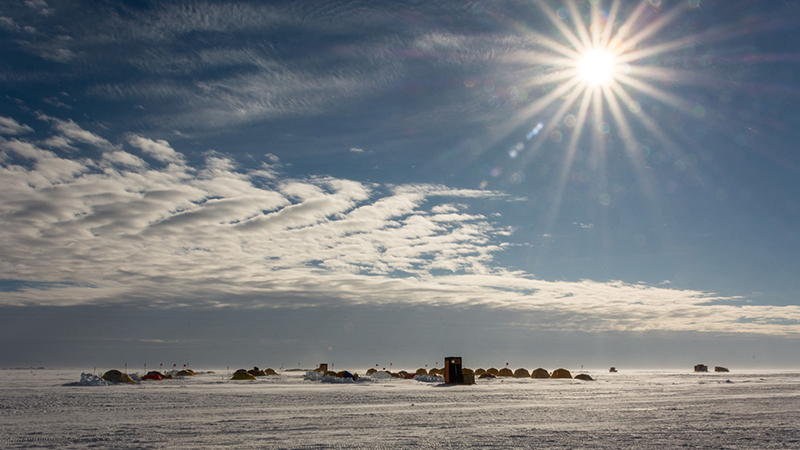SALSA Part II: Drilling DeepPart Two of a Two-part Series on the SALSA ProjectPosted November 18, 2019
Editor's note: This is the second of two Antarctic Sun articles chronicling the Subglacial Antarctic Lakes Scientific Access project. This installment dives into how microorganisms have survived in waters that haven't seen the sun or atmosphere for thousands to perhaps hundreds of thousands of years, and what they can tell researchers about the history of the ice sheet. 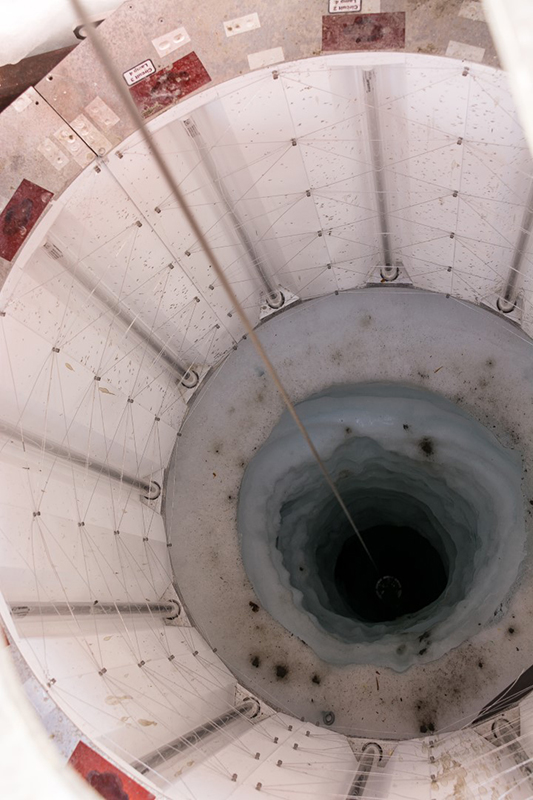
Photo Credit: Mike Lucibella
The team's drillers bored through more than three-quarters of a mile of ice to reach the lake below. The collar at the top of the borehole emitted powerful ultraviolet radiation to disinfect all instruments going down into the lake.
Does "Life find a way," even after thousands of years in lakes buried under hundreds of meters of Antarctic ice? That's a question that a team of researchers and drilling engineers spent six weeks this past season working to answer, drilling through nearly a mile of ice to study Mercer Subglacial Lake, a body of water buried under a solid sheet of ice. Researchers with the Subglacial Antarctic Lakes Scientific Access project, or SALSA, in part are trying to better understand how the West Antarctic ice sheet behaves, and what its future may be in a warming world. But the scientists also want to know what's happening under the ice in an environment that hasn't seen the light of day for as many as thousands, and perhaps hundreds of thousands, of years. There's a whole system of water that flows around under the ice, and there is the potential that microscopic creatures could somehow thrive in that environment despite being completely cut off from the sun and atmosphere. The only way to get a complete picture of what's happening under the ice was to carefully drill into it and sample the waters and sediments directly. "We've all come together on this interdisciplinary project,” said John Priscu, an ecologist at Montana State University and chief scientist of the project. "The theme of the SALSA project is to study carbon transformations of this [aquatic subglacial] environment and how much it’s related to past climate." 
Photo Credit: Billy Collins
With the help of the camp's crane, researchers retrieve a deep sediment core sample from the bottom of the lake.
SALSA is supported by the National Science Foundation, which manages the U.S. Antarctic Program. Keeping It CleanAt its peak during late December 2018, the SALSA camp was home to more than 50 people, including scientists, drillers and support staff. In order to transport all of their supplies, the drill, and all scientific equipment to the site, the team had to haul it more than 650 miles from McMurdo Station across the barren Ross Ice Shelf and up the Whillans and Mercer Ice Streams. Over two seasons, tractors hauled nearly a million pounds of equipment and material to and from the remote site. Once all the equipment arrived and camp was set up, the drillers set about melting a deep hole into the ice sheet with their hot water drill to reach the lake more than 1,000 meters below. The drilling itself took about a week, and once they reached the lake, they were ready to take their first samples from the lake. But they had to be careful. Critical to this effort was ensuring that the entire process was as clean as possible to protect the environment below. "Clean access is really important for two reasons, one to protect the continent. It's the last untouched frontier," Priscu said. "Secondly to protect our samples. My philosophy is if we protect our samples, we will protect the environment because we go overboard to ensure that our samples are uncontaminated and environmental cleanliness just follows." Before drilling even started, the researchers took numerous steps to make sure the entire process was clean and free of any contamination. The hot-water drill uses filtered water at a temperature high enough to essentially pasteurize the water, killing any surface microbes immersed in it. All scientific devices and instruments that went down the borehole into the lake were thoroughly cleaned and sprayed with disinfectant to prevent hitchhiking microbes from disrupting any ecosystem below. In addition, at the surface, the team installed a ring of powerful ultraviolet lights to further sterilize all equipment. 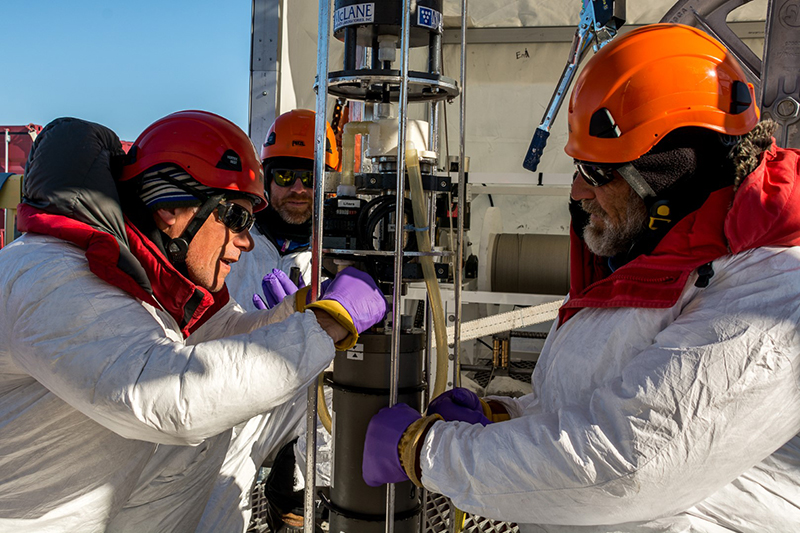
Photo Credit: Mike Lucibella
(Left to right) Michael Tepper-Rasmussen, Jack Greenberg and John Priscu prepare a water filter to drop into the lake and collect samples of floating particles and sediments in the water column.
"Anything that goes down that borehole goes through this huge UV lamp ring that can cook a hot dog," Priscu said. Chasing CarbonCarbon is the key to understanding what's happening under the ice. The element is critical for life to function, so understanding how organisms consume and process carbon reveals a great deal about a food chain. At the same time, the presence or lack of a particular isotope of radioactive carbon can help scientists date the age of the ice sheet and the sediments that underlie it. "We're using a special radiocarbon technique that I've developed to try and ascertain whether or not there's a presence of any radiocarbon," said Brad Rosenheim, a marine scientist at the University of South Florida. "The reason why is if there is radiocarbon in any of these samples, they had to be in contact with the atmosphere where radiocarbon forms in the last 50,000 years or so." Pinning down how long the West Antarctic Ice Sheet has been around is difficult. Microfossils found embedded in the sediment under the ice in other nearby regions show that five to 15 million years ago, the ice sheets covering Antarctica were a shadow of what they are today. "The ice sheet was quite a lot smaller, the sea would have covered a larger area and therefore this would have been a marine embayment, or a huge big bay," said Mark Skidmore, an Earth scientist at Montana State University. But how many times the ice sheet formed, collapsed, and reformed again, is a big open question. If it started forming many hundreds of thousands or even millions of years ago and remained solid until now, any carbon down there would be ancient and scientific tools would allow researchers to date it very accurately. 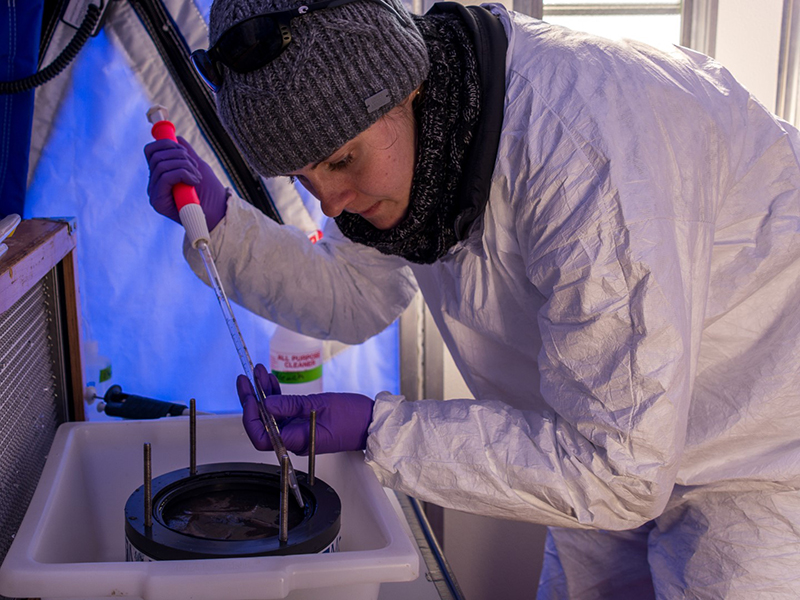
Photo Credit: Mike Lucibella
After retrieving the water filter, Trista Vick-Majors extracts the floating particles and sediments for analysis.
"If that was the original deposition, and there was nothing else that has happened here ever since, and this lake has just been in the dark, there should be no radiocarbon," Rosenheim said. The particular isotope of carbon that Rosenheim is analyzing, carbon-14, is slightly radioactive, and only forms when carbon is exposed to cosmic rays from the sun. Trace amounts are ubiquitous in all terrestrial and marine ecosystems. However, in environments isolated from the atmosphere, such as ones underneath more than a thousand meters of ice, the existing radiocarbon decays at a predictable rate and can’t be replenished, eventually disappearing from the system all together. If the team finds any radiocarbon in their samples it means the ice has covered the region for at most 50,000 years and the West Antarctic Ice Sheet may be less stable and more vulnerable to collapsing as the climate warms. Should the West Antarctic Ice Sheet collapse, it would not only dramatically affect sea level around the world, but the very carbon the researchers are studying under the ice could have a serious effect on global climate. "There's potentially a lot of carbon stored beneath Antarctica and if the West Antarctic Ice Sheet does melt relatively rapidly, which some models predict might happen, then you have the potential to expose and or release a lot of carbon," Skidmore said. "There's been a lot of debate and discussion about could there be a lot of methane produced beneath the ice, that then if the ice sheet melts relatively rapidly, it's released into the atmosphere." To look at the ice sheet’s history even farther back, paleontologists David Harwood of the University of Nebraska-Lincoln, and Amy Leventer of Colgate University, studied the microscopic fossils embedded within the sediments recovered from beneath the ice. This allowed them to identify and date times when a great sea covered the area where the West Antarctic Ice Sheet is today. By looking for sediment layers with the fossilized remains of marine diatoms—tiny microscopic algae that form the bottom of the Antarctic marine food web—they can tell even more about when in the distant past the ice sheet retreated and carbon from these algae was deposited. 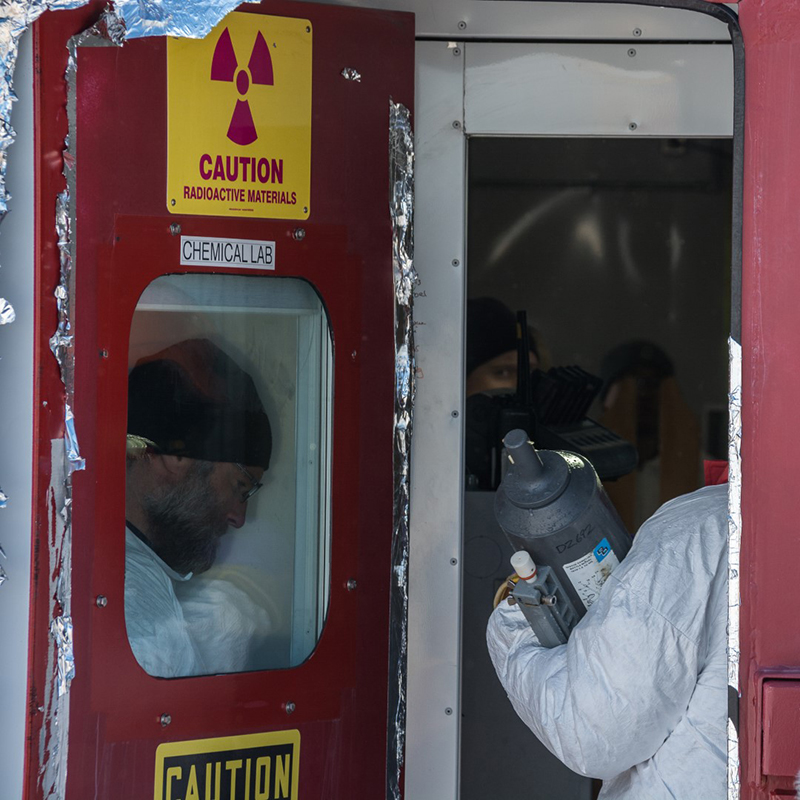
Photo Credit: Mike Lucibella
Researchers bring a water sample secured into a Niskin bottle into the lab designated for radioisotope testing. The project's two labs are kept separate so the radioisotopes don't contaminate the carbon-dating samples.
"We can tell when it went away whenever we have marine fossils here," Harwood said. "We could tell those times when there were seaways here because we're trying to figure out who lived here what was the climate like at those times, we can use those diatoms to date those rocks by correlations to other sites." It's AliveAt the same time researchers are also studying the carbon cycle of the creatures that currently live in the cold depths. "Lake Mercer is dominated by microbes," said Wei Li, a microbiologist at Montana State University. "I'm looking at who's living there and why they're living there and how they live there." Carbon is also the key to understanding how these critters survive. Scientists believe that the microorganisms that live in the lake subsist on carbon leftover from before the current ice sheet covered the region. This "legacy carbon" forms the critical first rung of the restricted food chain in these subglacial environments. "The first thing is to try to find out if there is any life there and what kind of bio-density is there," said Li. "We took the water up, and we have a specialized microscope set up in the field lab and we use a dye to stain the DNA (which all living organisms have) so the bacteria will light up under the microscope. Then we count the cells and look at the morphology of them to figure out their density in Lake Mercer. That gives us a first impression of the status of life down there." 
Photo Credit: Mike Lucibella
(Left to right) Timothy Campbell, Ryan Venturelli, and Brad Rosenheim prepare a to collect core samples using a "multi-corer." To prevent contamination of the lake below, researchers wear Tyvek suits and clean all equipment with disinfectant before lowering it into the lake.
Initial results indicate that it’s hard for the organisms to survive in these dark, isolated environments; nutrients are rare and life is sparse. Li is now working to understand what kind of organisms, if any, are there and how they consume the carbon that's around. In particular, Li together with other biologists on the SALSA team are looking to see what dominates the ecosystem: whether it's organisms that can produce their own food using the existing legacy inorganic carbon—autotrophs—or organisms that feed on other organisms and therefore rely on organic carbon, heterotrophs. "To identify the sources of material that support life in this unique ecosystem, scientists on the team are looking at all kinds of analyses, especially stable isotope measurements," Li said. "That will give us a tremendous amount of information about how the environment formed and where the sources of water, organic carbon and sediments are." To study how the microorganisms consume the carbon and how it moves through the food web, Li and teammate Trista Vick-Majors, also at the University of Montana, fed some organisms small amounts of a radiocarbon tracer in their lab. This slightly radioactive carbon isotope is easy to track, and can clearly illustrate how nutrients move through the ecosystem. 
Photo Credit: Mike Lucibella
Researchers take a look at lake sediments collected by the multi-corer. This soil from the bottom of the lake can offer hints as to what lives below and how long the ice sheet has existed.
It's a powerful tool for understanding the ecosystem's carbon cycle, but they had to be careful about using it at the same site as the research team trying to use radioactive carbon isotopes to date the sediment. The naturally occurring radiocarbon that scientists use for carbon dating occurs in such trace amounts that the teams had to take extra steps to make sure not to inadvertently contaminate each other's samples. If any of the tracer radiocarbon were to accidently spill over into the carbon dating samples, it would completely throw off all of their measurements. To ensure that this did not happen, scientists built two completely separate labs for the experiments, one where researchers could use their tracer radiocarbon, and one that was designated radiocarbon tracer-free where they could carbon-date samples without worrying of contamination. "We're taking very strict precautions in limiting the amount of crossover of equipment," Rosenheim said. "Not even a screwdriver should move between that lab and this lab, let alone a person." It's the first time these two techniques have been used so close together. The researchers developed this "separated environment" to be able to use research techniques right next to each other that were long thought to be essentially mutually exclusive because of the risks of cross-contamination. The two techniques complement each other, allowing researchers to gain a more complete understanding of both the ancient history and present conditions of the lake, thus significantly increasing the amount of information gathered during the project. 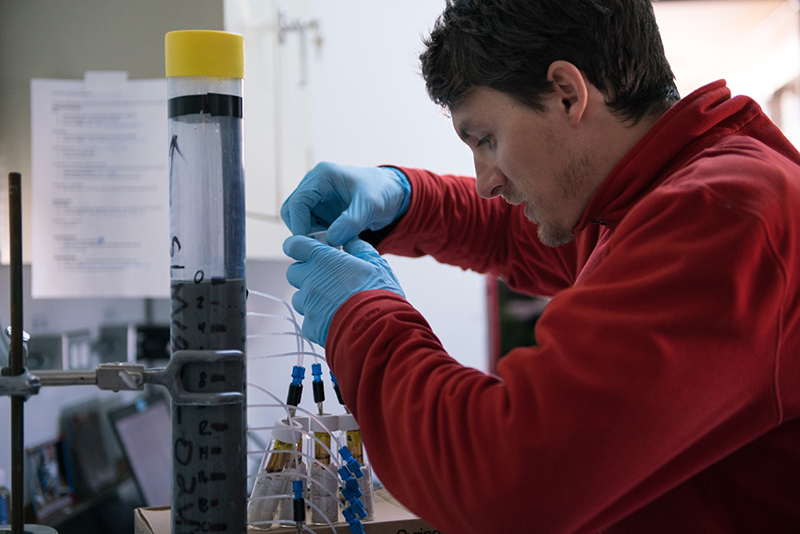
Photo Credit: Billy Collins
Alex Michaud analyzes soil samples retrieved from the bottom of the lake.
"Hopefully we've developed a protocol that allows these two powerful techniques to be done side by side," Skidmore said. "There's a lot of folklore in my community that you cannot work anywhere near anybody who's working with tracers and I hope we can maybe put an end to that by developing a good protocol and being good stewards of each of our labs." The researchers are still poring through the numerous samples they took during their time on the ice sheet. With so many to work through, the members of the team will be sequencing microbial DNA, analyzing water and studying fossil specimens for many months to come. "We're going to be spending a lot of time in laboratories [with] students looking through microscopes, processing samples, and analyzing the results," Priscu said, adding that in addition to the more than 25 U.S. scientists, SALSA has international collaborators as well. "We have samples that are going to Korea, we have samples going to Italy, we have samples going to the UK, so there's a lot to do and a lot to keep track of." NSF-funded research in this story: Amy Leventer, Colgate University, Award No. 1543405, Brad Rosenheim, University of South Florida, Award No. 1543347, Brent Christner, University of Florida, Award No. 1543396, W. Berry Lyons, Ohio State University, Award No. 1543453, John Priscu, Montana State University, Award No. 1543537. |



For USAP Participants |
For The Public |
For Researchers and EducatorsContact UsU.S. National Science FoundationOffice of Polar Programs Geosciences Directorate 2415 Eisenhower Avenue, Suite W7100 Alexandria, VA 22314 Sign up for the NSF Office of Polar Programs newsletter and events. Feedback Form |

